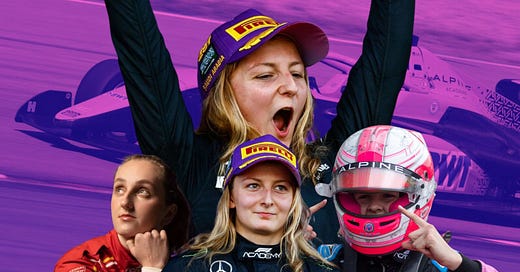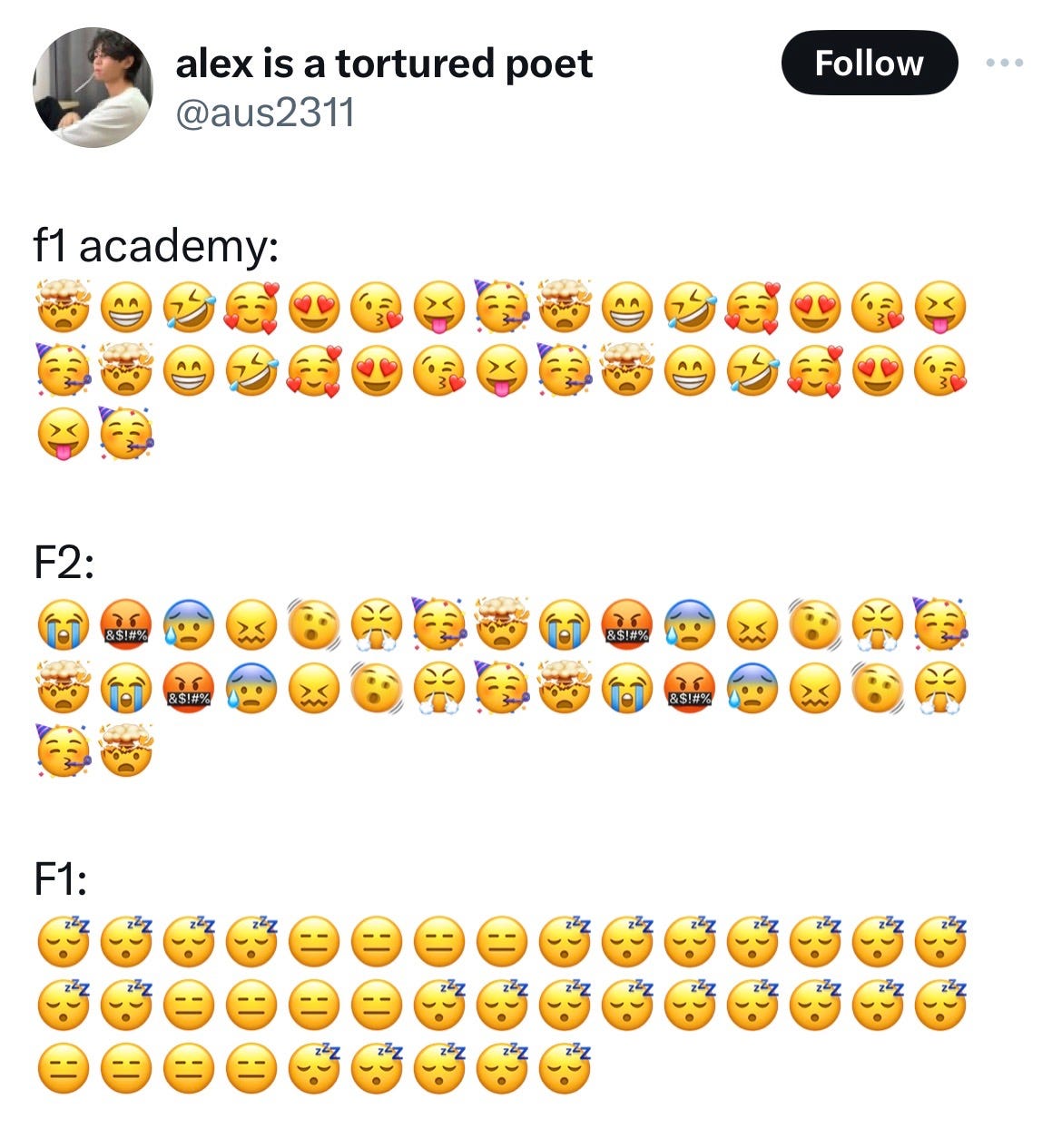Doriane Pin for President
In an age of Formula 1 repetition, feeder series are stealing the spotlight
The Saudi Arabian Formula 1 Grand Prix finished in a familiar fashion. Similar to the previous race and six of last season’s grands prix, two navy blue Red Bulls crossed the checkered flag ahead of the other 18 drivers.
Amid the routine finishing order, the 3.8-mile track relied on a last-minute rookie appearance and a few well-timed defensive strategy calls to draw eyes to all 50 laps. Despite the race’s merits, the sport’s feeder series took home the prize for on-track action.
Formula 2’s Oliver Bearman drove in Carlos Sainz's place over the weekend while the Ferrari driver watched on — stitched up post-appendicitis. At just 18 years old, Bearman became the youngest rookie to grace the F1 grid for Ferrari and the first rookie driver to clinch an F1 debut in the Rosso Corsa car in 52 years. Finishing well within points scoring range, Bearman now sits in tenth place in the championship standings — racking up more points in the elite racing series after one race than in his F2 day job. Bearman held off Lando Norris, Nico Hulkenberg and seven-time World Champion Lewis Hamilton.
Saturday’s race under the lights gave viewers a bit more to dissect than last weekend. Hamilton’s ability to stretch a used medium tire compound for 36 laps was a masterclass on performance outweighing finishing position. Kevin Magnussen’s defensive tactics allowed his Haas teammate to stop by the pit box without losing his track position and Oscar Piastri secured a fourth-place finish despite overtaking without help from the Drag Reduction System (DRS). The handful of penalties (and the few illegal moves that went unpunished), however, did little to cease cries of boredom.
While F1 remains the most-watched racing series, the weekend revealed a growing online rhetoric: Why watch F1 when F2 and F1 Academy offer a rousing fight?
Most eloquently, one social media user expressed the sentiment solely in emoji-speak.
For F2, Enzo Fittipaldi, champion of Italian Formula 4, took his first race win after clawing his way up front. The midfield featured back-and-forth position swapping with scrappy overtakes sprinkled with colorful language and bleeped radio messages. Dennis Hauger, a Red Bull junior and winner of the 2021 Formula 3 Drivers’ Championship, sprinted from fifth to third on the last lap — overtaking two cars at once mere feet from the finish line.
But the real show began once F1 Academy hit the Jeddah street circuit.
The all-female racing series is still in its infancy. After a debut season in 2023 featuring an experimental format, the series has smoothed out any lumps in qualifying layout and driver lineup. This year, the series will compete on the same weekends as F1 for seven rounds with each round including two races. One starting grid is determined by a driver’s fastest qualifying lap and the other by her second-fastest. F1 Academy’s novel Wild Card Entry format allows for a local driver from each race host country or region to compete.
Similar to F1, one driver dominated the F1 Academy weekend. But this time, audiences weren’t complaining. Doriane Pin, a 20-year-old racer and one of the four Iron Dames, scored a practice, qualifying and double race win hat-trick. Her second win stuck until a miscommunication led the driver to speed around the street circuit an additional lap after the checkered flag waved.
While the race stewards’ decision to slap Pin with a 20-second penalty cost the French driver the win, it also brought attention to the series as the international racing community stepped in. Everyone from F1 commentators to Formula E drivers sped to social media to denounce the penalty and support the F1 Academy driver. While doing so, videos circulated that showed the series’ wheel-to-wheel racing and the potential of its 15 drivers.
Pin — who set a qualifying time nearly a second faster than the runner-up (an uncommon gap in a spec series with an even playing field) — sat at the center of this awe, along with Abbi Pulling who won the second race following Pin’s penalty. Spectators began to call Pin, sponsored by Mercedes, the next Hamilton.
The series, aiming to create a pipeline for women to reach F1, is backed this year by all 10 F1 teams. Fans were quick to quip about the difference in performance between F1 and F1 Academy — with the caveat that one is an engineering competition with different car performance abilities while the other features machines with similar set-ups.
Chloe Chambers, an American F1 Academy driver, became the first Haas driver to score back-to-back points in a driver’s first two races for the team in eight years. Among Alpine F1 Team’s recent car struggles, Pulling, who is supported by Alpine F1 Team, was touted as the only Alpine driver who will grace the podium this season.
Sporting Alpine’s pastel pink, Pulling gives fans of the French team another driver to root for in 2024. But on-track action is only one aspect of F1 Academy’s charm.
Friday’s race concluded with a wall of female race engineers wishing drivers a “Happy International Women’s Day.” Cameras stilling on young female pit crew members and engineers and the series’ managing director, Susie Wolff, made for a refreshing sight. After two weeks of F1 drivers tip-toeing around a female employee’s allegations of inappropriate workplace behavior against Red Bull Team Principal Christian Horner, the sport hasn’t opened its arms to women as of late.
In a country where women could legally drive just six years ago, F1 Academy’s season opener offered a glimmer of hope for women’s future in F1.







Isn’t Enzo Fittipaldi Brazilian?